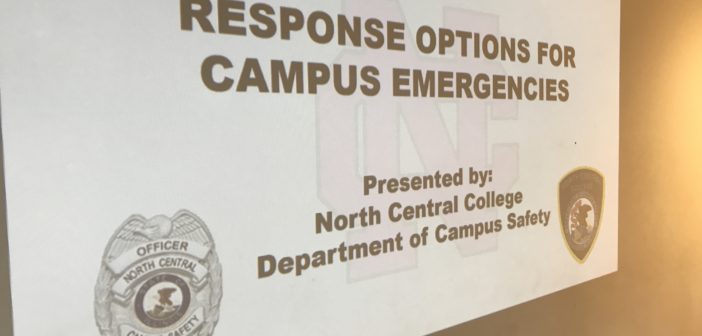“Run. Hide. Fight.” are the options laid out by the Department of Homeland Securities’ active shooter preparedness program. On March 1, a handful of North Central College students gathered into a boardroom in the New Hall dorms to go over the program just over two weeks after the Stoneman Douglas High School shooting that claimed 17 lives. Not even 24 hours later, two people were fatally shot in a dorm at Central Michigan University.
The presentation at North Central was led by Michael Willison, assistant director of campus safety. Willison, a former SWAT officer with 33 years of experience in law enforcement, walked the students through active shooter statistics, a brief history of mass shootings in America as well as the evolution of how law enforcement and schools have handled these horrific situations.
Willison talked about lockdown protocols that are practiced in schools and how “Run. Hide. Fight.” and the ALICE (Alert, Lockdown, Inform, Counter, Evacuate) training program has adapted what those schools and law enforcement have learned about active shooter cases. “Run” or safely evacuating is the ideal option in that scenario, Willison explained. “Hide” means turning off lights, locking and barricading doors; and “Fight” is a last resort, using improvised weapons to defend yourself.
In 2018, “Hide” is also beginning to utilize “Fight” strategies in some situations. “Passive and static targets become easy victims,” said Willison before recalling his own ALICE training as an officer where instead of sitting in the corner of a room during a lockdown the officers were encouraged to spread out and throw an improvised weapon to when the attacker entered to disorient the shooter in the training exercise.
“You’re going to participate in your own rescue,” said Willison.
According to Willison, “These instances only last eight to 10 minutes.” He then referred to a 2013 FBI study that showed 69.8 percent of active shooter situations ended in five minutes or less. “If you don’t prepare, you’ll freeze when that time comes.”
Some North Central students in attendance came away from the session with at least a little more of a sense of their options in that scenario. “(Run.Hide.Fight.) is something I’d want to do that they wouldn’t allow you to do in high school,” said first-year student Brandon Redd.
Another first-year, Kyra Norris, was particularly impacted by Willison’s plea to participate in your own rescue. “That’s so powerful because in a lockdown you do nothing and he actually wants us to do something, to fight back, don’t be a sitting duck,” said Norris. “I think that makes us feel a lot safer, personally. It feels like at least I’ve got more than one option.
Aside from training, Willison also highlighted the importance of anti-bullying efforts as well as helping students that are showing signs of depression. Recent Secret Service studies have shown that 71 percent of shooters had been “bullied, threatened, attacked or injured,” while 98 percent had “experienced a profound sense of failure or loss.”

